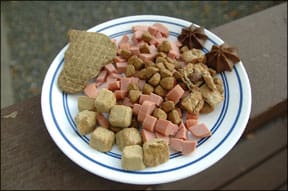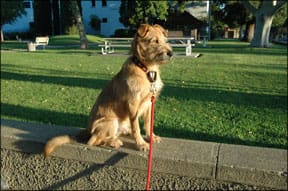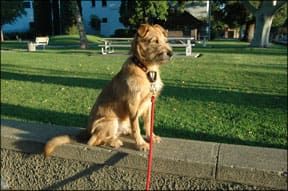It’s going to be really difficult to stay caught up with everything we’ve been going through with our new dog, Otto. Every day brings new surprises and challenges, and these experiences are piling on at a quick clip.
Building a healthcare team
In our first week together, I had to deal with something I hope I don’t need again any time soon: finding a good local veterinarian. In articles like “Coordinating Care” (Whole Dog Journal May 2002), “The Importance of Integration” (October 2004), and “Practice Management” (December 2006), we’ve discussed the importance of finding healthcare professionals that you like and that are capable of meeting your expectations – before you actually need them. I wanted to start on this project right away.

In a perfect world, all dog owners would have easy, local access to a vet who is a warm-hearted, well-educated dog lover, a brilliant diagnostician (fully equipped with all the latest diagnostic tools) who is open to (if not familiar with) complementary care. However, in the real world, many of us have to use several different practitioners as parts of a “healthcare team” to meet all their needs, as well as their dogs’ needs.
When providing emergency care for Cooper, my father-in-law’s elderly dog, in what turned out to be Cooper’s last days, I had lucked into an appointment with a practitioner who seemed to be a very good diagnostician with a very well-appointed clinic and laboratory. If Otto ever needs diagnostic or emergency care, I’d go straight to that clinic again. Considering the vet’s skills, I’d consider it only a bit of an inconvenience that his clinic is a good 30-minute drive from my home.
I’ve been asking my friends about holistic practitioners; there aren’t any within an hour’s drive. If I need one soon, I may end up hauling Otto down to the Bay Area holistic practitioner I relied on several years ago to provide care for my darling Rupert. It’s a three-hour-drive, but it’s probably what I’d do.
I’d also like to find a veterinarian with a practice close to my home, one who could provide routine, practical care, such as annual health exams and urgent treatments. My first attempt at finding such a practitioner was not terribly successful.
When I adopted Otto, the shelter gave me a coupon that was good for a free health exam at a dozen or more local participating clinics. I wanted to contact one right away to obtain a prescription for a heartworm preventive; mosquitoes and the infamous infection they carry are rampant in our part of Northern California.
I wasn’t wildly impressed with the veterinarian I took Otto to for this purpose. His technicians were personable and friendly to Otto, but the vet himself expended absolutely no effort to establish any sort of rapport with me or my dog. He even seemed mildly annoyed when I asked him to give Otto a few treats (which I handed to him) before he began his exam, to put Otto at ease.
I had already told the vet technician that I was there for the free exam and to get some heartworm preventive, so perhaps that partially excuses the fact that the vet asked me only a few cursory questions about my dog. He then left the room, saying someone would be in to get Otto’s weight (so we could get the right dose of preventive), and I did not see him again! He neither engaged me in discussion about heartworm, fleas, ticks, diet, or behavioral health, nor outlined his suggestions for future healthcare practices or local hazards I should be aware of as a dog owner new to the area. If I was an inexperienced dog owner, I’d have left the clinic completely clueless as to my next healthcare responsibilities for Otto.
Again, this was a free exam, so what could I expect? On the other hand, a really engaged, proactive vet could have sold me some high-quality dog food; made sure I really understood how heartworm infections occur and how and when to administer the preventive; suggested running a blood test (it’s a good idea to have these results, which can provide a baseline or history in case of future health problems); discussed the prevalence of ticks in our area and the dangers of tick-borne diseases (and sold me a tick-control product); detected and discussed Otto’s mildly irritated skin; and so on.
Suffice to say that I’ll keep looking for another candidate to be our local, “family practitioner” vet.
Diet considerations
Like most dog owners, I really appreciate the convenience of dry food for my dog’s daily diet. If it develops that Otto has special health needs, I’ll consider a wet, dehydrated, or raw frozen diet, all of which are more expensive, less convenient, but healthier than kibble, in my opinion. In the meantime, Otto is going to get a high-quality kibble, with lots of treats, as well as occasional doses of wet food (frozen into Kong toys, representing a part of our “stay awake during the day” program; I’ll write more about this later).

This switch might come sooner than I’d like; I’ve noticed that Otto scratches and chews himself regularly. By regularly, I mean that I see him doing it at least once a day – not in a frantic or obsessive way, but daily nonetheless. His skin looks a little red in some places, and his stools often contain a small amount of hair, confirming that he chews on himself daily.
Otto doesn’t have any fleas – I look for them daily – and I haven’t used any sort of flea control product on him. Shortly after we adopted him, I did bathe him with a gentle, natural shampoo, but I think it’s something else that is irritating his skin. Despite being given four different beds in different locations in and around our house, he sleeps during most of the day (more on this in a minute) in his sandbox (which I described in “Dig This! Not That!” last month), and spends a lot of time at night sleeping in the dirt in our front yard. It’s highly possible that there is something in the dirt – or something about dirty skin – that makes him itch. It’s also possible that there is something in his food that is causing his mild skin problems.
I’m keeping a “diet journal,” writing down what I’m feeding Otto in hopes that I might be able to identify any trend that emerges in terms of ingredients or types of food that aggravate his skin issues. I’m also keeping the ingredients panel from these foods stapled in the journal, and noting any sort of extra itching or redness of the skin I observe.
So far, I’ve fed Otto three different varieties of one company’s kibble, without seeing any major differences in his stool, skin, or enthusiasm for the food. However, I’m also feeding him a wide variety of treats. If his skin issue worsens, I may have to simplify his diet so I can zero in on which (if any) of his foods or food ingredients are contributing to the problem. As we’ve described in “Skin Secrets” (November 2005) and “Walking the Allergy Maze” (August 2004), allergy related skin problems can be challenging to solve, but a strict elimination diet (and keeping a food journal) is the best way to identify the offending foods.
Taking treats
In our first week together, I was concerned that I had inadvertently adopted a dog with a trait that makes reward-based training particularly challenging: a low level of interest in food and treats.
Dogs who are greedy eaters present their own challenges, but in general, dogs who are somewhat food-oriented are the easiest to train. Food treats are what trainers call “primary reinforcers” – something that (most) dogs like automatically. Positive trainers use a lot of treats in the early stages of training for a number of reasons. Here are the most important ones:
- Frequent treat ‘payouts’ classically condition the dog to form a positive association with the person who doles out the treats, thus strengthening the dog/human bond.
- Dogs pay more attention to people who give them treats; the treats help make the people more significant to the dog than other people.
- Treats can be used to desensitize the dog to new or scary stimuli.
- And of course, most critically, well-timed treats can be used to reinforce the behaviors you want your dog to repeat.
A good trainer can accomplish all of these things without the use of food, but primary reinforcers like treats definitely speed things up. In order to accomplish all of the above without treats, a person has to find something else the dog likes as much as food – and that can be difficult and time-consuming to do, particularly with a fearful or undersocialized adult dog.
This all explains why I was worried when, in the first week with Otto, he turned away from chicken, cheese, roast beef, tuna, wet cat food, and half a dozen different types of commercial, meat-based treats (freeze-dried and semi-moist). He would sniff each treat carefully, and about half the time, take it from my fingers very gently, chew it halfheartedly, and politely decline a second serving.
Stress case!
Thank goodness, Otto’s reluctance to take food was short-lived, an apparent artifact of his initial nervousness in his new home. In retrospect, I should have realized that it was a sign of anxiety. After all, I’ve witnessed many training sessions and classes with dogs who are so overstimulated and excited that they wouldn’t take even high-value treats from their handlers.
What fooled me into thinking that this wasn’t the case with Otto was the fact that he refused treats not only in highly stimulating environments (such as out on a walk), but also in the quiet of my kitchen or backyard. Plus, he didn’t display the classic signs of stress that I’ve learned to spot, such as licking his nose, flattening his ears, tucking his tail, yawning, and so on.

I signed us up for a class with Sarah Richardson, a positive trainer in Chico, California (and frequent model for Whole Dog Journals’s articles), whose training center is about 20 minutes from my home. I consulted with Sarah before our first class, bemoaning Otto’s delicate appetite for treats. She gave me a few more ideas about treats to try, including string cheese and hot dogs . . . and suggested that Otto was still a bit stressed by his new environment.
Like every owner (or any parent whose child’s teacher made what seemed to be a mildly critical assessment of that child!) I demurred, convinced by Otto’s displays of affection toward me as evidence that he was quite comfortable. I did go to the store to buy hot dogs and string cheese, though. Voila! Hot dogs were the first food item that Otto took readily and enthusiastically, and they seemed to inspire him to give more consideration to other treats, too.
Looking back, though, I realize that my experienced trainer friend was right, of course: Otto was stressed. The signs he displayed, though, were far more subtle than the ones I was familiar with and looking for. Re-reading Pat Miller’s excellent article, “Stress Signals,” in the June 2006 issue, I realized that Otto had been displaying some of the items from Pat’s list of signs of canine anxiety.
In the article, Pat explained that dogs normally display appeasement and/or deference signals as everyday communication tools for keeping peace in social hierarchies. But when these signals are offered in conjunction with other stress-related behaviors, she wrote, they can be an indicator of stress as well. Otto, I now realize, was displaying slow movement; frequent sitting, lying down, or exposing his underside; and avoidance, in which the dog turns away and evades a handler’s touch and treats.
I could see that Otto was nervous when he turned away from or ducked away from a stranger’s touch. But I had been regarding Otto’s freely offered sits and downs as good manners; I hadn’t considered that they could also be signs of social anxiety. And I thought it was smart that he would proceed slowly when he was unsure of what to do. As the adolescent dog grows increasingly comfortable in our home, and gains socialization and experience in the world, I see these signals less and less.
Getting better all the time
As I write this, about seven weeks since we adopted Otto, he now will take just about every treat we give him, although he is more enthusiastic about some than others; hot dogs are still on the top of his list of favorites. When we go out for a walk, a training practice session, or to a class with Sarah, I load a “bait bag” with about five different treats, ranging from kibble to hot dogs. This gives me the ability to vary my reinforcements, saving the best treats for the most difficult or challenging behaviors I ask Otto to display.
Otto will still duck if someone reaches for him quickly, and he’s even growled a couple of times when he was startled by a stranger’s enthusiastic or physical greeting. It’s made me more aware of how unpredictable people can be around dogs, and how alert and proactive a handler has to be with a “soft” or nervous dog.
I try to hand treats to anyone who evinces the slightest bit of interest in my new dog, and ask them if they would give the treats to him. I briefly explain that the dog came from the shelter, is a little bit fearful, and we’re trying to get him past that. Generally, this elicits a bit of sympathy from people and they readily give Otto a treat or two, as well as a kind word.
As a result of consistently receiving treats from just about anyone who focuses on him or talks to him, Otto’s confidence in public and with strangers has really blossomed. My guess is that by the time I write the next installment of this column, he’ll be even more secure in his knowledge that the world is a reasonably safe place, and that he can relax and be friendly toward most people.
Nancy Kerns is Editor of Whole Dog Journal. She adopted Otto from a shelter on June 16, 2008.






